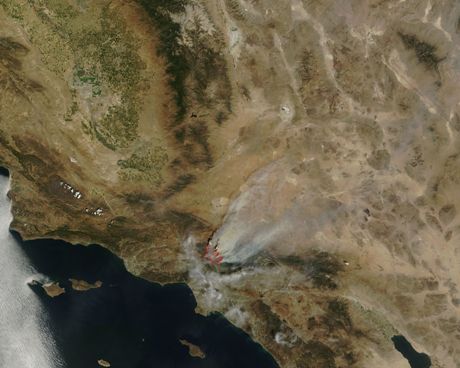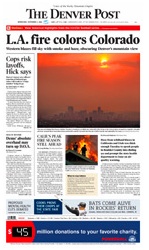Earlier this week I got an email from a colleague in Boulder, Colorado, remarking on the crimson sunsets and brown haze that had settled across the Front Range, apparently caused by drifting smoke from California’s wildfires. At that point the Station Fire complex in Los Angeles County had already charred nearly 150,000 acres.

My colleague Dan Brekke, an ardent watcher of elemental stuff like water and fire, featured a map of the spreading haze in his personal blog.
By Wednesday evening Brekke relayed that flames had consumed an area about the size of Chicago (and no, he couldn’t resist the low-hanging Mrs. O’Leary reference). With less than 30% containment, smoke had spread over about three-quarters of the state. Beyond California, NOAA had tracked the plumes “northward and eastward…across southern Nevada, Utah, Colorado, and Kansas.”

From The Denver Post:
“Joe Ramey, a meteorologist with the National Weather Service in Grand Junction, said that a high-pressure system is continuing to pump smoke from several California fires and 17 fires currently burning in Utah into the state. He said a fire near Nucla in south-central Colorado also may be contributing to the haze…Most of the smoke, however, is being generated by the 190-square-mile fire burning near Los Angeles, he said.”
While the current pall is not entirely California-born, it does make the point that large wildfires cast a surprisingly long shadow.
Atmospheric scientists classify smoke as an “aerosol” (any airborne particulate matter), which has a complicated set of feedbacks on the climate. For instance, aerosols encourage cloud formation and clouds have both positive and negative feedback effects on global warming. But it’s clear that smoke plumes generate greenhouse gases and also carry toxic air pollutants such as carbon monoxide.
Briefing journalists last month at the National Center for Atmospheric Research (NCAR)–in Boulder, no less–atmospheric chemist Gabriele Pfister said that wildfires have multiple effects on the atmosphere. They “disturb the carbon cycle,” interfering with energy exchanges and generating greenhouse gases. Itinerant smoke can generate ozone pollution far from the initial fires. This presents a challenge for local regulation of “ground-level” ozone, since it’s often likely an import from distant fires.
One thought on “Where There’s Smoke—And Where Isn’t There?”
Comments are closed.

These widespread wildfires are just one more wake-up call as the world rapidly approached an unprecedented catastrophe from global warming and many environmental threats. While it is generally being overlooked, animal-based agriculture is a major contributor to greenhouse gases, more than all the cars and other means of transportation wot=rldwide combined.
For more information, please visit JewishVeg.com/schwartz, where I have over 140 articles and 25 podcats of my talks and intrviews. Also, please visit ASacredDuty.com to see our acclaimed documentary “A Sacred Duty: Applying Jewish Values to Help Heal the World.”